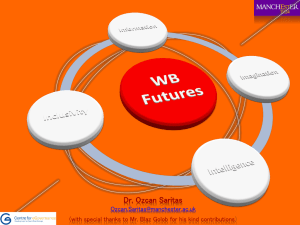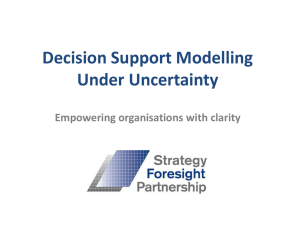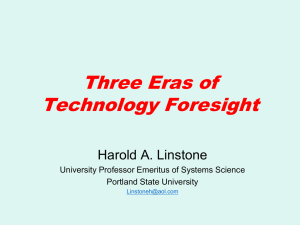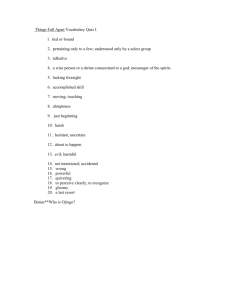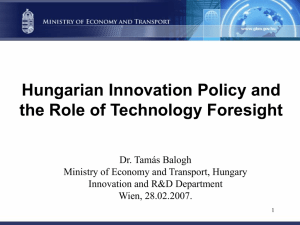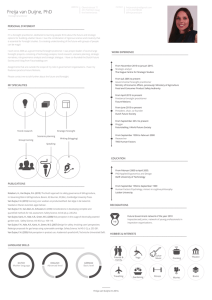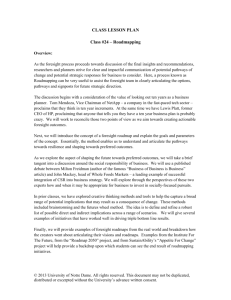Scenario Planning, Dr. Ozcan Saritas, The University of Manchester
advertisement
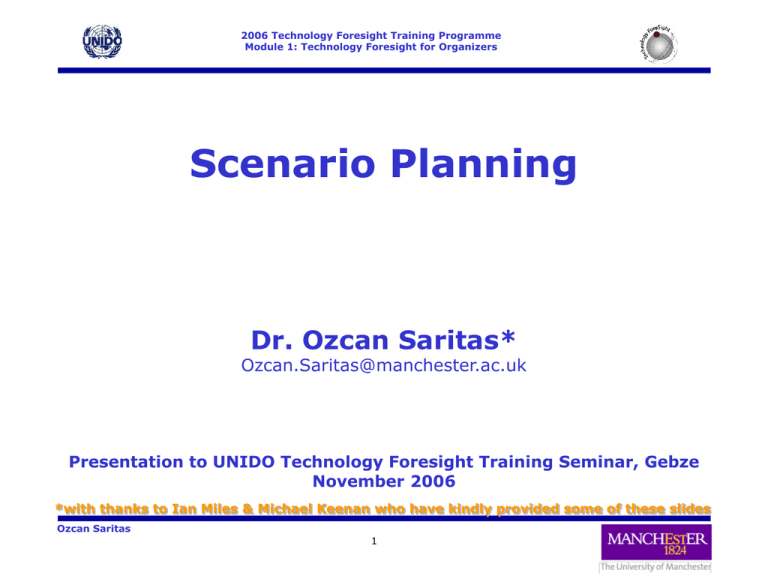
2006 Technology Foresight Training Programme Module 1: Technology Foresight for Organizers Scenario Planning Dr. Ozcan Saritas* Ozcan.Saritas@manchester.ac.uk Presentation to UNIDO Technology Foresight Training Seminar, Gebze November 2006 *with thanks to Ian Miles & Michael Keenan who have kindly provided some of these slides Ozcan Saritas 1 2006 Technology Foresight Training Programme Module 1: Technology Foresight for Organizers Outline Definition and historical background Characteristics of scenarios Variations in the use of scenarios Scenario generation process Methods used A CASE: Health Scenarios Ozcan Saritas 2 2006 Technology Foresight Training Programme Module 1: Technology Foresight for Organizers Definition Common definitions of the term “scenario”: – An outline of the plot of the dramatic work giving particulars of the scenes, characters, etc. – The outline or sometimes the complete script of a motion picture or a shooting script – An imagined sequence of events, especially any of several detailed plans and possibilities Ozcan Saritas 3 2006 Technology Foresight Training Programme Module 1: Technology Foresight for Organizers Definition Scenarios in the context of Foresight – Wack (1984): “a discipline for rediscovering the original entrepreneurial power of creative foresight in contexts of accelerated change, greater complexity and genuine uncertainty” – Schwartz (1991): ‘‘tools for ordering one’s perceptions about alternative future environments in which one’s decisions might be played out’’ – Gausemeier et al. (1998): “a generally intelligible description of a possible situation in the future, based on complex network of influence factors” Ozcan Saritas 4 2006 Technology Foresight Training Programme Module 1: Technology Foresight for Organizers Historical background The concept first emerged following World War II, as a method for military planning. The U.S. Air Force tried to imagine what its opponents might do, and to prepare alternative strategies In the 1960s, Herman Kahn, who had been part of the Air Force effort, refined scenarios as a tool for business prognostication Scenarios reached a new dimension in the early 1970s with Pierre Wack’s work in Shell, which enabled the company to anticipate the rise and subsequent fall of oil prices in 1973 Ozcan Saritas 5 2006 Technology Foresight Training Programme Module 1: Technology Foresight for Organizers Key assumptions in using scenarios The future not only is a continuum of past relationships and dynamics but also can be shaped by human choice and action The future cannot be foreseen completely, but extrapolation of the future can inform the decisions of the present There is not one possible future only. Uncertainty calls for a variety of futures mapping a ‘possibility space’ Development of scenarios involves both rational analysis and subjective judgement. It therefore requires interactive and participative methods (Berkhout and Hertin, 2002) Ozcan Saritas 6 2006 Technology Foresight Training Programme Module 1: Technology Foresight for Organizers Dual meaning of scenarios Image of the future: a state of affairs, describing the circumstances at a particular point in future time Future history: a “story” of the evolution of affairs, in the form of a sequence of events or developments of trends Now: where are we, what should we do... histories Ozcan Saritas 7 images 2006 Technology Foresight Training Programme Module 1: Technology Foresight for Organizers Essential characteristics of scenarios Internally consistent Link historical and present events with hypothetical events in the future Carry storylines that can be expressed in simple diagrams Plausible Reflect predetermined elements Identify signposts or indicators that a given story is occurring (van der Heijden, 1997) Ozcan Saritas 8 2006 Technology Foresight Training Programme Module 1: Technology Foresight for Organizers A successful scenario Describes the possible future changes in a particular ‘system’, domain, environment, society, etc. Involves the imagination Are written in the past or present tense - as if the visualized trends & events had already happened Indicates the causes and consequences of key developments Challenges our current images & conjectures about the future Helps us to create and evaluate alternative policies, strategies and actions Is seen as relevant and an important element of the strategic decision/policy making process Ozcan Saritas 9 2006 Technology Foresight Training Programme Module 1: Technology Foresight for Organizers Variations: Single vs. Multiple Single Scenario – To illustrate and communicate features of forecasts and future-relevant analyses – To provide a framework in terms of which views of different aspects of future developments can be integrated and their consistency or otherwise examined – To structure and guide discussion so that visions, elements of visions, and the assumptions that underpin such visions, can be explicated and elaborated. – To set a target (e.g. for aspirational purposes) Ozcan Saritas 10 2006 Technology Foresight Training Programme Module 1: Technology Foresight for Organizers Single vs. Multiple Multiple Scenarios – To illustrate alternatives, indicate a range of plausible developments (not one inevitable future path); to assess robustness of strategies; to stimulate reflection on underlying assumptions – To give insight into contexts and outcomes (intended or otherwise) of actions, & conditions when objectives may be realised; to help identify turning points, key decisions, indicators, early warnings of change Common to use 3 or more scenarios Ozcan Saritas 11 2006 Technology Foresight Training Programme Module 1: Technology Foresight for Organizers Normative vs. Exploratory Normative scenarios Starts with preliminary view of a possible future and look backwards to see if and how this might or might not grow out from the present Explorative scenarios Starts with the present as starting points and move forward to the future by asking ‘what if’ questions about implications of possible events outside familiar trends Use data about the past and present bearing in mind the possible, probable and desirable Ozcan Saritas 12 2006 Technology Foresight Training Programme Module 1: Technology Foresight for Organizers Inward vs. Outward Starting from the present (“exploratory”): What next? What if? Starting from the future (“normative”): Where to? How to? Ozcan Saritas 13 2006 Technology Foresight Training Programme Module 1: Technology Foresight for Organizers Outward Scenarios - Example Trends and events of particular interest to users not necessarily preferable ones A common framework for workshop and expert groups is STEEPV: Social Technological Economic Environmental Political Values Ozcan Saritas 14 2006 Technology Foresight Training Programme Module 1: Technology Foresight for Organizers Inward Scenarios - Example Futures of particular interest to users - not necessarily desirable ones : a PROFILE approach Will world economic development mean: High Growth What would it be like? Profile Profile 2 1 High Low Equality Profile Profile Equality 4 3 How do we Low Growth Ozcan Saritas 15 get there? 2006 Technology Foresight Training Programme Module 1: Technology Foresight for Organizers Methods for scenario planning Forecasts Deskwork Expert Groups “Modelling” tools like simulation, cross-impact; gaming Surveys, clustering articulated viewpoints Workshops Ozcan Saritas 16 2006 Technology Foresight Training Programme Module 1: Technology Foresight for Organizers Scenario workshops A scenario workshop allows the participants to: – exchange information, views and insights, – identify points of agreement, disagreement and uncertainty – create new shared understandings – develop action plans and other instruments so as to help mobilise future activity Ozcan Saritas 17 2006 Technology Foresight Training Programme Module 1: Technology Foresight for Organizers A model for the organisation of a scenario workshop Step 1: Set up a preliminary objective including the time horizon Step 2: Establish a broad learning programme under the STEEPV guidelines to enable the boundaries appropriate to the objective to be derived and the broad trends that influence the objective to be identified; and by asking ‘who and what’ is important to the objective, map out more specifically the driving forces for your organisation in creating its future Step 3: Make explicit the assumptions that will be used in writing the scenarios; examine these assumptions for their relevance, reasonableness and robustness in relation to the assumed objective; and, through iteration, modify both until a convergence is achieved Step 4: Assemble a framework of alternative event strings and trends that are the skeletons for the scenarios Step 5: Write the scenarios using whatever presentational technique seems to be most suited to the objective and the organisation’s culture Step 6: Analyse the scenarios with particular reference to turning or branch points that may constitute a crisis Step 7: Derive from the analysis, the policies within which the organisation ought to work (the limits of actions the organisation ought not to exceed in seeking to achieve its objective), the instruments of policy over which the organisation has control and those that are beyond its control Step 8: Using the instruments of policy, derive alternative strategies Step 9: Evaluate these strategic alternatives over the chosen timescale, Ozcan Saritas particular attention to the strategic allocation of resources, including paying 18 financing, and the best routes to achieving the desired financial returns 2006 Technology Foresight Training Programme Module 1: Technology Foresight for Organizers Product & process benefits of scenario planning Product (codified outputs) - reports, books, videos. Discursive accounts, summaries, action lists and priorities. Inputs to decision making. – Scenarios: integrate diverse studies, concretise and communicate visions; suggest action points and key indicators Process (embodied knowledge) - forging and enriching networks, developing knowledge about knowledge. Establishing and empowering constituencies for action. – Scenarios: recruit support, integrate diverse viewpoints; share & fuse visions, provide focus for joint work. Ozcan Saritas 19 2006 Technology Foresight Training Programme Module 1: Technology Foresight for Organizers How to get it wrong (Coates) Mechanical Extrapolation – limits, ceilings, qualitative change Unexamined assumptions Limited Expertise – failure to see limits, connections Limited Vision – failure to see outsiders, novelty, significant events Ozcan Saritas 20 2006 Technology Foresight Training Programme Module 1: Technology Foresight for Organizers Integrating scenarios with other methods Scenarios can be used with other methods such as – – – – – – Expert panels STEEPV analysis SWOT analysis Some research on the area of interest Road mapping and/or Delphi Ozcan Saritas 21 2006 Technology Foresight Training Programme Module 1: Technology Foresight for Organizers Health scenarios The future of Health and Social Services in Europe for the European Monitoring Centre of Change (EMCC) Step 1: Understanding the healthcare system – A review of Health and Social Services in Europe – Trends and driving forces Step 2: Scenarios – – – – Analysis of the Healthcare and Social Services system Health and Social Services Scenarios Towards integrated visions Wildcards Step 3: Policy and action proposals – European health policy landscape – Community action programme for public health – Specific policy challenges Ozcan Saritas 22 2006 Technology Foresight Training Programme Module 1: Technology Foresight for Organizers Step 1: Understanding the healthcare system Definitions of “healthcare sector” and “social services” – The healthcare sector refers primarily to those services provided by hospitals, general practitioners and community clinics in the prevention, diagnosis, and treatment of illness – Social services is confined to work rendered by any person or organisation in furtherance of the general welfare of citizens. This includes, • • • • • children and their families; isabled people of all ages; elderly people (especially those with mental health problems); people who misuse drugs and alcohol; and services in relation to HIV/AIDS Ozcan Saritas 23 2006 Technology Foresight Training Programme Module 1: Technology Foresight for Organizers Step 1: Understanding the healthcare system Statistical data: Figure: Total expenditure on health as % GDP Ozcan Saritas 24 2006 Technology Foresight Training Programme Module 1: Technology Foresight for Organizers Step 1: Understanding the healthcare system Trends and driving forces: – – – – – Demographic and societal change Rising expectations and consumerism Health informatics and telemedicine New medical technologies Increasing costs of health and social services provision Figure: Age groups 15-24 and 55-64 as % of age group 15-64 – EU15 – 1995-2025 Ozcan Saritas 25 2006 Technology Foresight Training Programme Module 1: Technology Foresight for Organizers Step 1: Understanding the healthcare system Demographic and societal change Table: Trends and drivers effecting the health and social services sector Ozcan Saritas 26 2006 Technology Foresight Training Programme Module 1: Technology Foresight for Organizers Step 2: Scenarios Understanding of the interdependencies and dynamics of the health and social services system Figure: Interdependency of sub-systems in the welfare system Ozcan Saritas 27 2006 Technology Foresight Training Programme Module 1: Technology Foresight for Organizers Ozcan Saritas 28 2006 Technology Foresight Training Programme Module 1: Technology Foresight for Organizers Step 2: Scenarios Existing scenarios from the health and social services Ozcan Saritas 29 2006 Technology Foresight Training Programme Module 1: Technology Foresight for Organizers Ozcan Saritas 30 2006 Technology Foresight Training Programme Module 1: Technology Foresight for Organizers Step 2: Scenarios Nine indicators around which there are variable degrees of uncertainty 1. Health status of the population: life expectancy; morbidity rates, especially amongst the elderly; health divides and health tiering 2. Lifestyles and values: individualism versus collectivism; standing of expert knowledge; consumption; intergenerational harmony and/or ageism; life-style drugs 3. Health and social care funding regimes: dependency ratios; public versus private/market provision; cost containment measures; co-payments and self-rationing; incentives (e.g. reduced insurance payments) to encourage self-care 4. Prevention and self-care 5. Growing and changing demand on services 6. Widespread use of ICT 7. Genomics and biotechnology 8. Primary and community care 9. Employment organisation and workforce skills Ozcan Saritas 31 2006 Technology Foresight Training Programme Module 1: Technology Foresight for Organizers Step 2: Scenarios Three integrated visions 1. A best ‘guesstimate’ 2. Problem plauged 3. Visionary Ozcan Saritas 32 2006 Technology Foresight Training Programme Module 1: Technology Foresight for Organizers Step 2: Scenarios Ozcan Saritas 33 2006 Technology Foresight Training Programme Module 1: Technology Foresight for Organizers Step 2: Scenarios Wildcards – “…events that have less than a 10 per cent chance of occurring, but will have a tremendous impact on society and business if they do occur” (R.Amara et al, p.xxii) Ozcan Saritas 34 2006 Technology Foresight Training Programme Module 1: Technology Foresight for Organizers Step 3: Policy and action proposals European health policy landscape Community action programme for public health Figure: EC’s action programme on public health (2003-2008) Ozcan Saritas 35 2006 Technology Foresight Training Programme Module 1: Technology Foresight for Organizers Step 3: Policy and action proposals Specific policy challenges: – – – – reforming health and social care funding systems; exploiting ICT; tackling major health determinants; exploiting and regulating developments in genomics and other biotechnologies Ozcan Saritas 36 2006 Technology Foresight Training Programme Module 1: Technology Foresight for Organizers Summary Future is uncertain and thus there is multiplicity Scenarios are helpful – to create multiple images of the future, thus – to be ready for the alternative courses of future developments Scenarios elicitate and represent knowledge of participants in an interactive and coherent way Scenarios are widely used in Foresight exercises, not only for the product benefits, but also for the process benefits Ozcan Saritas 37 2006 Technology Foresight Training Programme Module 1: Technology Foresight for Organizers UNIDO Training Programme on TF 2006 TF for Organisers – Module 1 Questions / Comments? Dr. Ozcan Saritas Ozcan.Saritas@manchester.ac.uk Ozcan Saritas 38
